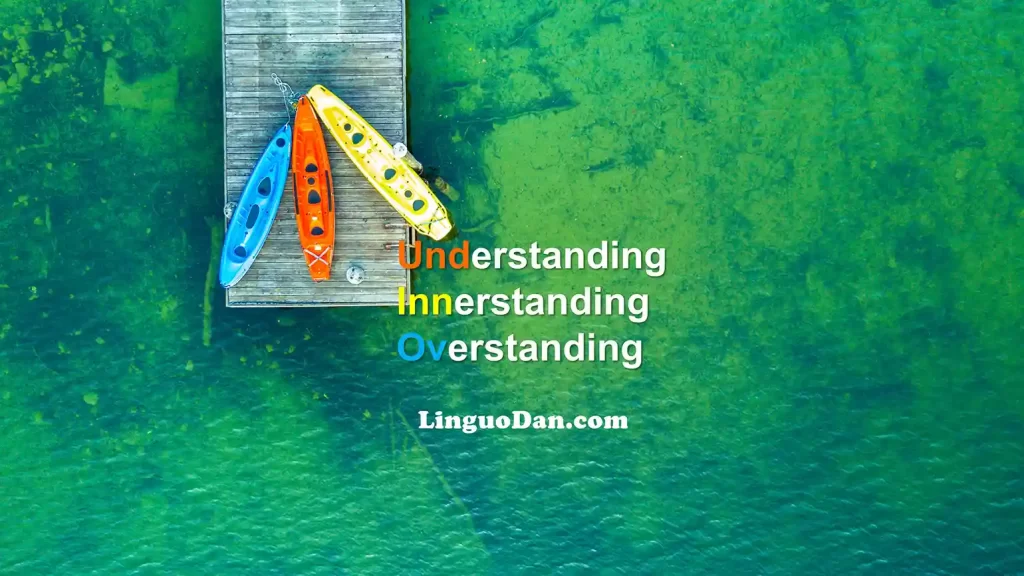Difference between Understanding, Innerstanding, and Overstanding

What’s the difference between Understanding, Innerstanding, and Overstanding?
We’re all familiar with the common English word “understanding,” but hearing words like “innerstanding” or “overstanding” can immediately raise questions about what they mean and how they differ from “understanding.” In brief, understanding refers to a basic comprehension of information or a concept. It’s like vanilla ice cream: simple, yet satisfying. When you learn about a new topic and can explain it, that’s understanding. Innerstanding implies a deeper understanding that stems from your inner experiences and emotions. It’s when you don’t just understand the information, but feel it on a profound level, like how a song can evoke powerful emotions within you. Overstanding represents a high level of understanding that sees the broader context. It’s like viewing life from a mountaintop, comprehending the cultural and historical nuances that influence the present situation. Let’s explore what each of these terms means and how they differ.
Understanding – Meaning and usage
In English, “understanding” refers to the ability to comprehend, grasp, or explain certain information or a situation. It can be used as both a noun and a verb. Let’s look at each usage:
As a noun, “understanding” relates to the state or process of comprehending something. For example:
- “She has a deep understanding of the subject.”
As a verb, “to understand” means to perceive the intended meaning or nature of something. For example:
- “I understand the instructions.”
In grammar, “understanding” is used in different tenses and forms depending on the context of the sentence. For instance, in the simple present tense:
- “He understands the problem.”
In the past tense:
- “They understood the joke.”
And in the future tense:
- “We will understand more after the meeting.”
Innerstanding – Meaning and usage
“Innerstanding” is not a standard word in English, but it is used in spiritual and philosophical contexts to describe a deep, intuitive understanding. It’s a combination of the words “inner” and “understanding,” indicating an understanding that stems from inner experience and insight.
Usage of “Innerstanding” in English:
- As a noun: “His innerstanding of the self is profound.”
- In phrases: “She speaks from a place of innerstanding.”
Grammatically, “Innerstanding” is an uncountable noun and does not have a plural form. It is used to describe a state or quality, rather than referring to a specific quantity or measurement.
While “Innerstanding” is not part of traditional English grammar, it can be used to emphasize a personal, deep understanding of a subject or situation, especially in contexts where the importance of inner experience and intuition is highlighted.
Innerstanding allows us to forge a deeper connection with our own experiences and those of others, leading to increased self-awareness. It is a process that fosters personal and spiritual growth, as it focuses on developing a deeper bond with our thoughts, emotions, other people, and experiences.
Overstanding – Meaning and usage
In English, “Overstanding” is sometimes used in certain contexts to describe a concept that goes beyond traditional understanding. It is often employed to indicate a re-evaluation or assessment of a situation from a higher perspective, transcending conventional understanding. This word is not part of standard English but can be encountered in spiritual, philosophical, and cultural discussions.
“Overstanding” is frequently used to emphasize the idea that a person not only understands information on a surface level but also perceives a deeper meaning and broader context. The word can also imply a raising of consciousness and attainment of enlightenment.
Grammatically, “Overstanding” is used as a noun and does not have a standardized form in English. It is not pluralized and does not have different tense forms like regular verbs.
Here is an example of using “Overstanding” in a sentence:
- “Through meditation and self-reflection, he achieved a level of overstanding that transcended his previous understanding of life.”
While “Overstanding” is not part of traditional English, it can be employed in certain contexts to convey a profound understanding or enlightenment.
Differences between Understanding, Innerstanding, and Overstanding
Depth of Realization:
- Understanding encompasses basic comprehension and knowledge.
- Innerstanding delves deeper, to the level of personal experience and intuitive insight.
- Overstanding transcends the personal, offering a meta-perspective or higher assessment.
Process of Gaining Knowledge:
- Study and analysis are key to understanding.
- Personal experience and self-knowledge pave the way to innerstanding.
- Reflection, critical thinking, and empathy form the basis for overstanding.
Practical Applications:
- Understanding has universal applications in academic and professional spheres.
- Innerstanding has found its place in personal growth, psychology, and spiritual practices.
- Overstanding is often employed in contexts requiring deep, reflective analysis or within certain cultural traditions.
While understanding, innerstanding, and overstanding differ, together they open pathways to more meaningful engagement with our surroundings. Having them in your lexical arsenal allows you to more accurately convey the nuances of your thoughts and experiences.